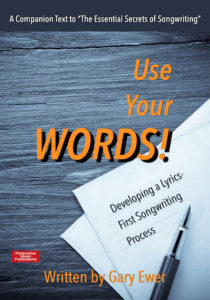It sometimes amazes me how different a verse and chorus can be from each other. The classic example of this is probably Paul Simon’s “My Little Town“, which features a long meandering verse with a complex chord progression, syncopations and changing time signatures. The chorus changes character almost completely, offering a very short, catchy hook as its main idea.
 Become the kind of songwriter where your lyrics get some attention. Gary’s newest eBook, “Use Your Words! Developing a Lyrics-First Songwriting Process” is FREE with your purchase of “The Essential Secrets of Songwriting 10-eBook Bundle.”
Become the kind of songwriter where your lyrics get some attention. Gary’s newest eBook, “Use Your Words! Developing a Lyrics-First Songwriting Process” is FREE with your purchase of “The Essential Secrets of Songwriting 10-eBook Bundle.”
Those kinds of songs can take some time to work out. But if you’re looking for an easier way to pull something together quickly, it’s very possible to create a verse and chorus melody, both of which use the same chord progression.
A good recent example of this is “I’m Not the Only One” (Sam Smith, James Napier). Both verse and chorus melodies are created over this nice turnaround:
F A Dm Bbmaj7 (I V/vi vi IV7)
If you write a song like this, where everything up to the bridge is constructed above the same chord progression, the question is: how do you make the verse sound like a verse and the chorus sound like a chorus?
There are two main ways that important differentiation is made:
- Write a chorus melody that sits mainly higher in pitch than the verse; and
- Hold some of those higher notes longer.
The higher-pitched chorus is a common technique, of course, that I’m sure you’re well acquainted with, and it’s a chorus feature I mention a lot on this blog. That one characteristic would probably be enough to make the chorus sound like a chorus.
But the other important feature of this chorus is the benefit that comes from holding certain notes longer, particularly higher-pitched ones. When a high note is held longer, we pick up a sudden amplifying of the emotional content of the lyric and melody:
“You saaaaaaay… I’m crazy…”
The Right Chord Progression
Not every progression will be the kind that can work for both a verse and a chorus. The best ones are progressions that are mainly STRONG in the tonal sense. Strong in this context means that the tonic chord (F, in this case) is featured prominently. The progression doesn’t stray too far away from that chord.
This progression (F A Dm Bbmaj7) makes F an obvious target, but that A chord, which is technically a secondary dominant, adds a nice bluesy touch that will work in either a verse or a chorus.
(If you’d like to know more about secondary dominant chords and how to work them into your songs, please read my blog post, “How to Add a Secondary Dominant to Your Chord Progressions.”)
So the characteristics of the chord progression that works in both a verse and a chorus can be summarized this way:
- Keep it short.
- Keep it tonally strong (i.e., make the tonic chord important).
- Add a moment of interest that doesn’t pull you away from the key (i.e., use a secondary dominant, a modal mixture, or some other interesting altered chord).
And the final piece of the puzzle, of course, is making sure that the verse and chorus melodies sit in different ranges, with the chorus usually requiring a higher melody.
Do those things, and you’ve got a verse-chorus combination that will both work nicely with the same chord progression.
 Written by Gary Ewer. Follow Gary on Twitter.
Written by Gary Ewer. Follow Gary on Twitter.
 Thousands of songwriters are using The Essential Secrets of Songwriting eBooks to straighten out their songwriting problems. Have you been spending years just reinforcing errors? Sort out your technique! Get today’s free deal!
Thousands of songwriters are using The Essential Secrets of Songwriting eBooks to straighten out their songwriting problems. Have you been spending years just reinforcing errors? Sort out your technique! Get today’s free deal!










